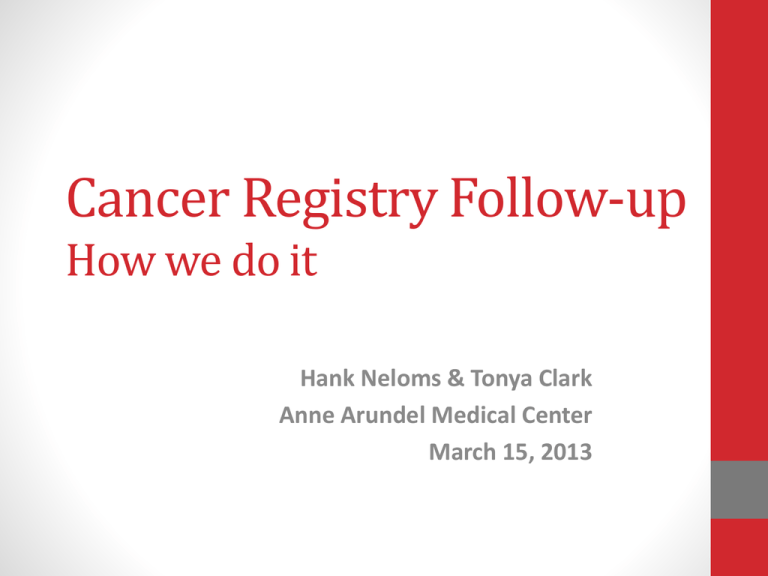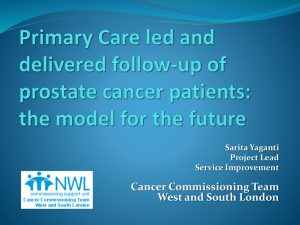
Cancer Registry Follow-up
How we do it
Hank Neloms & Tonya Clark
Anne Arundel Medical Center
March 15, 2013
Agenda
• Cancer Follow-up
• Confidentiality
• Standards
• Exclusions
• Timing
• Preparation
• The Process
• Follow-up Letters
• Lost to Follow-Up
• CRISP
• Questions
Cancer Follow-up
• The objectives of Follow-up are:
To determine outcomes of treatment
To determine the patient’s current vital status
Collect information on any recurrence including treatment and
any new primary cancer.
Confidentiality
• Confidentiality must be maintained when obtaining patient
follow-up
• Cancer Registries must have policies and procedures approved
by the cancer committee that includes both a written and
verbal contacting compliance with Federal law, State law, and
hospital policy.
• Our hospital policy is to contact only the patient’s physicians
and the patient themselves. We do not make a practice of
contacting the patients relatives or loved ones.
Standards
• Cancer Registries are required to fulfill the following CoC
standards:
Standard 5.3: 80% follow-up rate for all eligible analytic patients
from the registry reference date.
Standard 5.4: 90% follow-up rate for all eligible analytic patients
diagnosed within the last five years.
Exclusions
• Non-analytic cases, reportable by agreement, class of
case 0 (diagnosed after 1/10/2006),
• All patients over the age of 100 years old
• Carcinoma in-situ of the cervix
• Benign and borderline histologies
• In-situ and localized basal and squamous cell carcinomas
of the skin
• Foreign residents
Preparation
• All registries generate mailing lists of patient who will soon
become lost to follow-up (No contact after 15 months).
• This process of researching patients should begin at 12
months from their last date of contact and continue until they
become lost to follow-up after 15 months.
• A mailing list should be prepared consisting of patients that
range from 12 months after their most recent date of contact
to 15 months after the most recent date of contact.
• Before these letters are printed and mailed, this list should be
checked against your hospital’s database to see if any patients
have been treated at your facility.
• Once the list has been audited and the patient’s contact status
has been updated, the mailing list should be run again. All
updated patients will not show up on the new mailing list.
The Process
• Once the mailing list has been researched, letters can be
mailed out using the “FMRP” method.
• All patients who have not been updated in 12 months should
have a follow-up letter sent to their following physician (F).
• All patients who have not been updated in 13 months should
have a follow-up letter sent to their managing physician (M)
• All patient s who have not been updated in 14 months should
have a follow-up letter sent to their referring physician (R)
• All patients who have not been updated in 15 months should
have a follow-up letter sent to the patient himself (P)
Follow-up Letters
• Patient Letter
Recovery Status
Attending MD Info
Address Confirmation
• Physician
Date of Last Contact
Recurrence
Obituaries
• Obituaries should be checked once a week to capture any of
your patients who have expired.
Lost to Follow-up
• Patients are considered delinquent /Lost to Follow-up when
there is no record of their health status after 15 months.
• Names of patients who are lost to follow-up (delinquent)
should remain in the follow-up system until follow-up is
obtained
• This lost to follow-list should be audited periodically to
determine that all lost to follow-up remain in the system and
are continually pursued for current follow-up.
Timing – How we do it
• Weekly
Obituaries are checked
• Monthly
Patients on mailing list is audited against hospital database.
Patient and physician letters mailed out
• Twice yearly
Lost to Follow up list from the reference date audited
CRISP – A Follow-up Resource
Chesapeake Regional
Information System
()
Registration
• Access CRISP portal: http://hie.crisphealth.org/
• Register for the CRISP training webinar session
• Submit User Request
• Following the webinar submit photo ID to complete
• application process
• Once confirmation email is received you may use the
provided password to access CRISP for treatment
purposes only.
CRISP
A Follow-up Resource
Access CRISP Portal.
Log onto CRISP website.
Click Continue to website.
You have entered the patients virtual
health record.
Click patient lookup.
Enter patient’s demographics: Last
Name, First Name and Date of Birth
then click search.
CRISP – A Follow-up Resource
• When your query returns a result, click the radial
button to “Accept Usage Terms and Conditions”
• Click continue
• You now have access to outside encounters for
that patient
• Choose a link that may be useful in your quest
for follow-up data
• Repeat the process to query other patients.
Questions?









